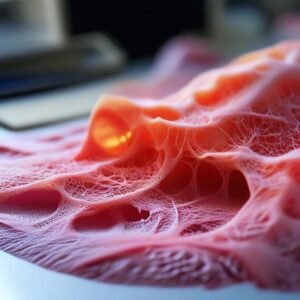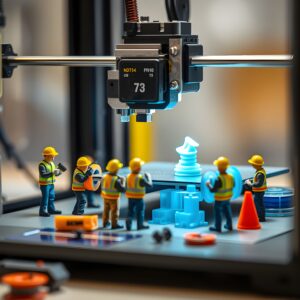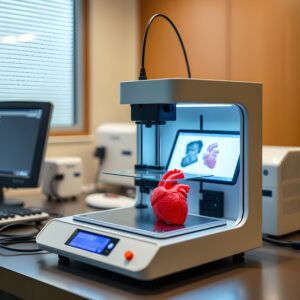The Impact of 3D Printing in Healthcare: Case Studies, Benefits, and Future Prospects

Explore how 3D printing is transforming the healthcare industry by revolutionizing medical devices, prosthetics, and personalized treatments. Learn about its applications through real-world case studies and future innovations.
The Role of 3D Printing in Healthcare
3D printing, also known as additive manufacturing, is making significant strides in various industries, with healthcare being one of the most transformative. The ability to create highly customized medical devices, prosthetics, and even entire organs has revolutionized the way healthcare professionals approach treatment and patient care.
In recent years, the healthcare industry has seen a growing trend of utilizing 3D printing to create personalized, cost-effective, and efficient solutions. From 3D-printed prosthetics that are more affordable and comfortable to advanced surgical tools and bioprinted tissues, 3D printing is paving the way for a new era in medicine.
This article will explore the profound impact of 3D printing on healthcare by discussing five groundbreaking case studies. These examples illustrate the diverse applications of 3D printing in medicine, including prosthetics, medical devices, surgery, and tissue engineering.

Case Study 1: 3D-Printed Prosthetics for Amputees—The Case of Open Bionics
Open Bionics is a company that has gained attention for its innovative use of 3D printing to create affordable and customizable prosthetic limbs for amputees. Traditional prosthetics can be expensive and uncomfortable, but 3D printing allows for a more personalized approach to design and functionality.
Open Bionics: Empowering Amputations with Custom Prosthetics
Open Bionics uses 3D printing to produce prosthetic limbs that are lightweight, functional, and visually appealing. The company’s Hero Arm is a bionic prosthetic arm that is customized for each patient using 3D scans. The arm is not only functional but also comes in a variety of designs, allowing users to express their individuality.
The Hero Arm has already been used by many amputees worldwide, providing them with greater independence and improving their quality of life. The cost of the Hero Arm is a fraction of traditional prosthetics, making it accessible to a wider range of people in need.
Benefits and Results
The Hero Arm offers several advantages over traditional prosthetics, including improved functionality, affordability, and personalization. The use of 3D printing allows for rapid prototyping, which speeds up the development of prosthetic limbs and reduces costs. Additionally, the design flexibility of 3D printing means that prosthetics can be tailored to the individual’s specific needs, resulting in better comfort and functionality.
Open Bionics is a prime example of how 3D printing is making prosthetics more accessible, comfortable, and cost-effective for amputees worldwide.
Case Study 2: 3D-Printed Surgical Models: Precision in Preoperative Planning
Another remarkable application of 3D printing in healthcare is the creation of 3D-printed surgical models. Surgeons can now use patient-specific models to plan and rehearse complex surgeries before performing them, which leads to better outcomes and fewer complications.
3D-Printed Surgical Models in Complex Surgeries
One of the most notable examples of 3D-printed surgical models is the use of 3D printing at the Mayo Clinic in Rochester, Minnesota. Surgeons at the clinic have used 3D-printed models to plan surgeries for patients with complex medical conditions, such as congenital heart defects and brain tumors. By creating a physical, patient-specific model of the affected area, surgeons are able to better understand the anatomy, visualize the surgical procedure, and minimize risks.
Benefits and Results
The use of 3D-printed models in preoperative planning provides several advantages, including:
- Improved precision: Surgeons can visualize and practice the procedure in advance, leading to better surgical outcomes.
- Reduced risks: By rehearsing the surgery with a physical model, the likelihood of complications is minimized.
- Personalized care: Each model is customized to the patient’s specific anatomy, ensuring that the surgical plan is tailored to their needs.
This case demonstrates how 3D printing can enhance the precision and safety of surgeries, ultimately improving patient outcomes.
Case Study 3: Bioprinting Human Tissues: The Case of Organovo
Organovo is a bioprinting company that has made significant strides in using 3D printing to create functional human tissues. Their goal is to revolutionize drug testing and personalized medicine by developing 3D-printed tissues that closely mimic human organs.
Organovo: Pioneering Bioprinting of Human Tissues
Organovo has developed 3D-printed liver and kidney tissues that can be used in drug testing and disease modeling. These tissues are made by printing layers of human cells, creating structures that resemble real human organs in both function and appearance. By printing functional tissues, Organovo aims to reduce the reliance on animal testing and improve the accuracy of drug development.
In 2017, Organovo received FDA approval to use their 3D-printed liver tissue for toxicology testing, marking a significant step toward the mainstream use of bioprinted tissues in medical research and testing.
Benefits and Results
Bioprinting offers several advantages for the healthcare industry, including:
- More accurate drug testing: 3D-printed tissues provide a more accurate representation of human organs, leading to better drug development and testing.
- Reduction in animal testing: By using human tissues, bioprinting can reduce the need for animal experimentation.
- Personalized medicine: Bioprinted tissues could one day be used for personalized treatments, allowing doctors to test drugs and therapies on a patient’s cells.
Organovo’s work is pushing the boundaries of 3D printing, bringing us closer to the possibility of bioprinting entire organs for transplantation in the future.
Case Study 4: 3D-Printed Implants for Skull Reconstruction—The Case of Stryker and the Complex Cranioplasty Procedure
Cranioplasty, the procedure of reconstructing a skull following injury or surgery, is one area where 3D printing has shown significant promise. Traditional methods of skull reconstruction can be time-consuming and lead to complications. However, the use of 3D-printed implants is making the process quicker, more effective, and personalized.
Stryker’s 3D-Printed Implants for Cranioplasty
Stryker, a global medical technology company, has developed 3D-printed implants for patients undergoing cranioplasty procedures. These implants are custom-designed using CT scans of the patient’s skull, ensuring a perfect fit. The implants are made from biocompatible materials, and the 3D printing process allows for precise, rapid manufacturing.
Benefits and Results
The benefits of using 3D-printed implants in cranioplasty include:
- Personalized fit: Each implant is custom-designed for the patient, ensuring a perfect fit and reducing the risk of complications.
- Faster recovery: The use of 3D-printed implants speeds up the surgical procedure, leading to faster recovery times for patients.
- Reduced risk of infection: Biocompatible materials reduce the likelihood of infection, a common concern in skull reconstruction procedures.
Stryker’s 3D-printed implants are transforming the field of neurosurgery by improving the efficiency and safety of cranioplasty procedures.
Case Study 5: 3D-Printed Hearing Aids: The Case of Phonak and Customization in Audiology
Phonak, a leading manufacturer of hearing aids, has adopted 3D printing to create highly personalized hearing aids that fit the unique anatomy of each patient’s ear. Traditional hearing aids often require multiple fittings and adjustments, but 3D printing has streamlined the process.
Phonak’s 3D-Printed Hearing Aids: A Step Toward Personalization
Using 3D printing, Phonak can create hearing aids that are tailored to the patient’s ear shape and specific hearing needs. The process involves taking 3D scans of the ear, designing the hearing aid in a digital model, and then printing it using biocompatible materials. This ensures a precise fit and a more comfortable user experience.
Benefits and Results
The main advantages of 3D-printed hearing aids include:
- Perfect fit: 3D printing allows for a highly personalized hearing aid that fits the ear perfectly, improving comfort and sound quality.
- Faster production: The customization process is quicker, allowing patients to receive their hearing aids in a shorter time frame.
- Affordability: 3D printing makes the production of custom hearing aids more affordable, reducing costs for both manufacturers and patients.
Phonak’s use of 3D printing is revolutionizing the field of audiology by providing more comfortable and affordable solutions for patients with hearing loss.
The Benefits of 3D Printing in Healthcare
1. Customization
One of the most significant advantages of 3D printing in healthcare is its ability to create personalized solutions. From prosthetics to hearing aids, 3D printing allows for designs that fit the individual’s unique anatomy, improving comfort, functionality, and effectiveness.
2. Cost-Effectiveness
By reducing the need for traditional manufacturing processes, 3D printing lowers production costs. This is particularly important in the healthcare sector, where custom medical devices and implants can be expensive. The affordability of 3D printing can make healthcare solutions more accessible to a wider range of people.
3. Faster Production
3D printing speeds up the manufacturing process, allowing for quicker turnaround times for medical devices and prosthetics. This is especially beneficial in time-sensitive medical situations, such as emergency surgeries or rehabilitation.
4. Reduction in Waste
3D printing uses only the materials necessary for the job, minimizing waste and making it an environmentally friendly manufacturing option. In healthcare, this means fewer resources are used to create medical devices, which can reduce the environmental impact of the industry.
FAQ: Frequently Asked Questions about 3D Printing in Healthcare
Q1: How does 3D printing benefit healthcare?
3D printing enables the creation of personalized, cost-effective, and efficient medical devices, prosthetics, and surgical tools, leading to better patient outcomes and faster recovery.
Q2: Can 3D printing be used to print human organs?
While 3D printing has made significant progress in bioprinting tissues, printing entire functional organs is still in the experimental phase. However, 3D-printed tissues for drug testing and disease modeling are already being used.
Q3: Is 3D printing in healthcare affordable?
Yes, 3D printing can significantly reduce the cost of medical devices, prosthetics, and implants by eliminating traditional manufacturing processes and allowing for customization.
Q4: What types of medical devices can be 3D printed?
3D printing can be used to create a wide range of medical devices, including prosthetics, hearing aids, surgical tools, and implants.
Q5: Are 3D-printed prosthetics as effective as traditional ones?
A: Yes, 3D-printed prosthetics are often more affordable, lightweight, and customizable than traditional prosthetics, and they provide similar or even superior functionality.
Q6: What are the challenges of using 3D printing in healthcare?
Some challenges include regulatory approval, ensuring biocompatibility, and the need for specialized equipment and expertise.
Q7: How does 3D printing improve surgical planning?
A: 3D-printed surgical models allow surgeons to plan and rehearse complex procedures, leading to more precise and safer surgeries.
Q8: Can 3D printing reduce the use of animal testing in healthcare?
A: Yes, 3D-printed tissues provide a more accurate alternative to animal testing, reducing the need for animal experimentation in drug development.
Q9: How is 3D printing used in the field of audiology?
3D printing allows for the creation of custom hearing aids that fit the unique anatomy of the patient’s ear, improving comfort and sound quality.
Q10: What is the future of 3D printing in healthcare?
A: The future of 3D printing in healthcare includes more personalized treatments, the possibility of printing organs for transplantation, and further advancements in bioprinting and medical device manufacturing.
The Future of 3D Printing in Healthcare
3D printing is revolutionizing healthcare by providing personalized solutions that improve patient care, reduce costs, and enhance treatment outcomes. As the technology continues to evolve, it holds the potential to transform every aspect of healthcare, from prosthetics and medical devices to surgical procedures and even organ printing. The future of 3D printing in healthcare looks promising, offering a new era of medical innovation that could improve lives worldwide.




